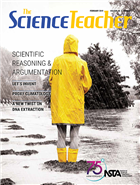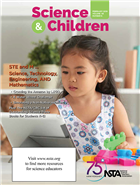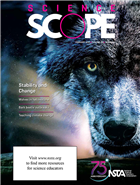Ideas and inspiration from NSTA’s February 2019 K-12 journals
By Mary Bigelow
Posted on 2019-02-15
In addition to an overview/review of the 5E model and the STEM disciplines, the Guest Editorial: Using the BSCS 5E Instructional Model to Introduce STEM Disciplines (in Science & Children)has a framework and suggestions for integrating the Model and STEM disciplines into planned and purposeful instruction. (An interesting read for all grade levels.)
Regardless of what grade level or subject you teach, check out all three K-12 journals. As you skim through titles and descriptions of the articles, you may find ideas for lessons that would be interesting for your students, the inspiration to adapt a lesson to your grade level or subject, or the challenge to create/share your own lessons and ideas.
The Science Teacher – Scientific Reasoning and Argumentation
Editor’s Corner: Scientific Reasoning and Argumentation – “When students defend and critique scientific explanations, experimental designs, or  engineering solutions, they learn to create and evaluate arguments using evidence and logical reasoning. Through critical discourse, they are challenged to distinguish opinion from evidence. They learn that argumentation is how scientists collaboratively construct and revise scientific knowledge.”
engineering solutions, they learn to create and evaluate arguments using evidence and logical reasoning. Through critical discourse, they are challenged to distinguish opinion from evidence. They learn that argumentation is how scientists collaboratively construct and revise scientific knowledge.”
The lessons described in the articles include a chart showing connections with the NGSS. The graphics are especially helpful in understanding the activities and in providing ideas for your own investigations.
- Incorporating argumentation does not necessarily mean a need to develop new lessons or investigations. A New Twist on DNA Extraction illustrates a modification of a traditional DNA extraction activity from follow-the-directions to an emphasis on protocol design and collaborative problem solving. The article includes examples of student work.
- The authors of Using Scientific Argumentation to Understand Human Impact on the Earth use the High Adventure Science project that guides students through the process. “When students hear “construct an argument” they often think in terms of an exchange of opposing viewpoints or an attempt to persuade others that an idea is correct or incorrect. Scientific arguments are different; developing a scientific argument involves defending a claim based on evidence, and should also include an examination of the evidence to determine its limitations and merits.”
- Let’s Invent! has suggestions for incorporating invention as a way to engage students in engineering design and local problems. The article describes two strategies that any teacher could use to start students inventing: Grab Bag Inventing and Problem Finding.
- Formatively Assessing NGSS addresses a need that many science teacher have: how to assess the three dimensions of the NGSS. The authors describe three models for assessment–sequential, concurrent, and embedded—with examples and tips. There is a helpful table showing how formative assessment strategies that teachers may already use can align with these models.
- “Proxy data are preserved physical characteristics of the environment that stand in—serve as proxies—for direct measurements.” Proxy Climatology shows how students used tree rings to investigate climate change. The author includes a link to the lesson, including rubrics and data sets.
- Focus on Physics: Quickly Teaching Speed, Velocity, and Acceleration—Part 1 takes a realistic look at prioritizing the number and depth of topics and distinguishing between the tool and concepts of physics.
These monthly columns continue to provide background knowledge and classroom ideas:
- Career of the Month: An interview with paleontologist Emily Lindsey
- Right to the Source: Learning to Think – An 1856 book from the Library of Congress encourages thinking in children.
For more on the content that provides a context for projects and strategies described in this issue, see the SciLinks topics Acceleration, Climate Change, Dendochronology, DNA, Motion, Paleontologist, Paleontology, Speed, Velocity
Many authors share resources related to the lessons and strategies in their articles. These resources include rubrics, graphic organizers, handouts, diagrams, lists of resources, and complete lessons. You can access these through the Connections link for The Science Teacher.
Keep reading for Science & Children and Science Scope.
 Science & Children – STE and M
Science & Children – STE and M
Editor’s Note: STEM Lessons for All – “STEM is more than just the collection of science, technology, engineering, and mathematics, or even the discrete attention to these four disciplines; it is the integration of disciplines used to find answers, solve problems, and create solutions. This month’s focus on STEM offers ideas for incorporating all four elements of STEM and provides support and guidance in creating STEM lessons for all students.”
The lessons described in the articles have a chart showing connections with the NGSS. Many are based on the 5E model and include classroom materials, illustrations of student work, and photographs of students engaged in the activities.
- Crossing the Amazon by LEGO integrates robotics and the engineering design to solve a problem. The authors also discuss low-tech options.
- Simulating a Non-Native Invasion includes a detailed unit plan for engaging students in the design of a computer simulation to model and predict how the introduction of an invasive species to an ecosystem affects native populations.
- You don’t need a lot of specialized equipment to engage students in STEM activities, as described in A Water Wheel Challenge! (check out the photographs). Students design, build, test, and refine a water wheel as they study energy conversions.
- Unpacking the STEM Disciplines exemplifies how STEM and the 5E model are a natural fit. In this unit, students take a global issue and personalize it at a local level as they are “guided through the four STEM disciplines in a personalized learning experience about the general theme of humans’ impacts on Earth and a specific place-based project on the use and disposal of plastic water bottles in the school.”
- What may appear to be play in The Early Years: Teaching the M in STEM is actually an investigation in which young learners observe motion and the properties of matter.
- Teaching Through Trade Books: Seasonal Weather Patterns has two related lessons. Sunshine and Seasons (K-2) focuses on observing the amount of daylight and the angle of the Sun’s rays. In A Picture of the Weather (3-5), students gather and graph data to look for patterns.
- Engineering Encounters: Authors and Engineers describes how students can learn engineering principles as they design, construct, and test pop-up books based on their own writing. The article includes photos of student work and has links to download materials.
- No excuses! Students of all ages are natural STEM learners. Teaching Teachers: Seven Myths of STEM debunks common misconceptions about designing and implementing STEM education activities and suggests sources for free or low-cost activities.
- Methods & Strategies: Improving the Quality of Engineering Design Challenges has five “optimizations” for guiding teachers, as students apply what they are learning to problem-solving designs.
These monthly columns continue to provide background knowledge and classroom ideas:
- Science 101: Why Does Water Swirl When it Goes Down a Drain? clears up misconceptions about this phenomenon.
- Formative Assessment Probes: Balance Beam has hands-on opportunities for students to explore algebraic equations.
- The Poetry of Science: Poetry by the Numbers
- Early Childhood Resources Review: Creative Investigations in Early Engineering & Technology
For more on the content that provides a context for projects and strategies described in this issue, see the SciLinks topics Coriolis Effect, Design, Energy Transformations, Engineering Structures, Environment, Forces and Motion, Invasive Species, Levers, Momentum, Physical Properties of Matter, Science of Bridges, Seasons, Weather, Weather and Climate, What Causes Earth’s Seasons?
Many authors share resources related to the lessons and strategies in their articles. These resources include rubrics, graphic organizers, handouts, diagrams, lists of resources, and complete lessons. You can access these through the Connections link for Science & Children.
 Science Scope – Stability and Change
Science Scope – Stability and Change
From the Editor’s Desk: Stability and Change—Integral to Systems – “Discussions and investigations related to topics such as erosion, evolution, and climate change can serve to explicitly highlight the connection of stability and change to systems…Possessing a deep comprehension of systems and how systems respond to change is essential when solving problems. Involving your students in this work parallels that of scientists and engineers and helps them see the interconnectedness of human-made and natural systems.”
Articles in this issue that describe lessons (many of which use the 5E model) include a helpful sidebar documenting the big idea, essential pre-knowledge, time, safety issues, and cost. The lessons also include connections with the NGSS.
- Cougars and Bears and Wolves, Oh Elk! has a lesson in which students modeled population changes, analyzed graphs, used their research as evidence to support a claim, and produced a written summary. The authors provide samples of handouts and rubrics.
- The question Is Our Water Safe to Drink? could apply to many communities. This project provided an authentic opportunity for students to investigate. The article includes a timeline for the lesson, student sketches, and suggestions for designing a filtration tool.
- Investigating Bark Beetle Outbreaks was the task of middle school students as they studied the effects of climate change on beetle populations and used a computer simulation to study changes over time and identify causes.
- Focusing on one of the NGSS performance expectations, Using Storylines to Support Three-Dimensional Learning in Project-Based Science describes a process and a planning tool to engage students in making sense of phenomena using a “storyline” that runs through a unit.
- Practical Research: Sound Practices in Climate Change Education elaborates on three themes: “connecting students with local climate change impacts; encouraging students to collect, analyze, and draw conclusions from their own data; and fostering relationships between climate scientists, teachers, and students.”
- The process in Teacher’s Toolkit: Using the Five Practices to Facilitate a Meaningful Discussion on Plate Tectonics in a Middle School Classroom includes anticipating, monitoring, selecting, sequencing, and connecting. The authors include examples from a middle school lesson.
- Citizen Science: Plant Phenology for Budding Biologists describes an ongoing project in which students observe changes over time and contribute their observations to a database about seasonal plant growth.
- Teacher to Teacher: Making Sense of Stability and Change notes how students should understand the concept of “systems” in order to contextualize their observations on how things change and how they stay the same. The authors discuss what this would “look like” in a real classroom (including a graphic organizer).
These monthly columns continue to provide background knowledge and classroom ideas:
- Disequilibrium: Surface Tension and Surfactants
- Scope on the Skies: The Van Allen Radiation Belts
- Interdisciplinary Ideas: Expanding the Power of Data Analysis with Google Sheets
- Science for All: Building a Bridge Over Homework—How to design at-home assignments that are both valuable and effective. The article includes a table on how to differentiate homework assignments.
- Making in the Middle: Robots and Sequences
For more on the content that provides a context for projects and strategies described in this issue, see the SciLinks topics Changes in Ecosystems, Changes to the Earth’s Surface, Climate Change, Ecosystems, Energy Transformations, Forces, Forests, Homeostasis, Limiting Factors, Plant Growth, Plate Tectonics, Predator/Prey, Radiation from the Sun, Robots, Seasons, Systems, Water Quality
Many authors share resources related to the lessons and strategies in their articles. These resources include rubrics, graphic organizers, handouts, diagrams, lists of resources, and complete lessons. You can access these through the Connections link for Science Scope.
Disclaimer: The views expressed in this blog post are those of the author(s) and do not necessarily reflect the official position of the National Science Teaching Association (NSTA).


